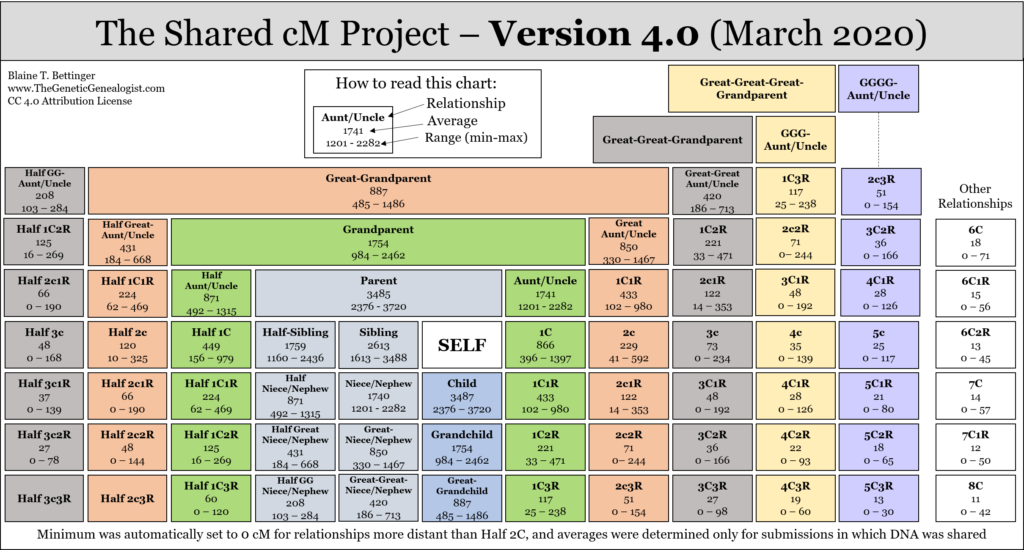In Part I, I gave a basic overview of what you can expect to learn from a DNA test. Ethnicity estimates, historical communities, and the surprises you might uncover with those two areas along with DNA matches that may be surprising. My example was from AncestryDNA but there are a handful of companies out there to test with (which I’ll dive into in future posts).
In this post, let’s shed light on some basics when looking at your shared matches.
Here’s an example of a result of a shared match showing the relationships between the two test takers (I confirmed the suggested one AncestryDNA gave me) and the amount of cMs we share. Lots of other info to glean from this set of results but I’ll save that for another post.

Shared Matches and Centimorgans (cMs)
A centimorgan (abbreviated cM) is a unit of measure for the frequency of genetic recombination. The easiest way I understand this is that a centimorgan gives you a measurement of how closely or distantly you may be related to someone. The higher the cM number, the more closely you are related to that match on your DNA list.
The numbers can vary from company to company, so you’ll want to use good judgement when comparing across company platforms, but they don’t seem to be drastically different. (For example, you won’t see that you share 1800cMs with a person you know that also took the test for one company, and then see you only share 50cMs with the same person on another company. It will be in the same ballpark of cMs.
If you want to learn more on centimorgans, I’m not going to copy and paste everything from a website and pretend to know all the really scientific stuff, but it is pretty interesting if you’re into genetics.
What Do the Amount of Centimorgans Mean?
There are a few charts floating around there, as well as the testing companies versions. I tend to reference this chart created by Blaine Bettinger, Ph.D., J.D. who is well known in the genetic genealogy community.
Relationship Chart
This chart can be very helpful in determining what possible relationships are between you and a DNA match. There are lots of variables, so be sure to evaluate what probable age/generation the match would be compared to you, as well as any possibility of half relationships or endogamy. There is an interactive/visual chart on DNApainter.com and I love it so much. Check it out here »

What if you find something unexpected?
Sometimes the numbers don’t seem to add up. Something seems off. Don’t go accusing people just yet. It’s not always a situation of misattributed parentage. There very well may be a scientific explanation for the data you’re seeing. Keep researching and digging until you can confirm with plenty of evidence that the results you’re seeing connect with the actual lineage of your family.
What if the results are telling a story you or others in your family aren’t ready to face?
Deep breaths. It can be complicated. And you’ll have lots of thoughts, questions, and feelings. Do yourself a favor and talk to someone about it. If you aren’t ready to talk to someone close to you, take the anonymous route for now until you feel ready. But know you aren’t alone.
There are rising numbers of people learning new information about their family identity as well as their own. It’s okay to process it, grieve it, or celebrate it—whatever the truth of the matter calls for. It takes time to wrap your head around something you always thought to be true, only to discover that all along history had been quite different.
If you don’t feel that the discovery has created enough of an upheaval to see a counselor or therapist (I’m not joking about that, if it has you should totally see one), there are facebook groups dedicated to providing not only help with your search(es), but access to people all over the country and the world who have shared a similar experience as you. Being understood in that specific way can help give you good perspective on your situation, along with the encouragement from people who have been or are in your shoes.
5 from the list to get you started:
Surprise DNA discoveries: https://www.facebook.com/groups/NPEOnlyAftertheDiscovery/
Finding biological family information for NPE/MPE/DC search and support https://www.facebook.com/groups/dnangelssupportgroup/
For Adoptees: https://www.facebook.com/TheSearchAngels
CeCe Moore’s DNA detective educational group: https://www.facebook.com/groups/798315666906219
Adoptees, NPEs, donor conceived https://www.facebook.com/groups/402792990448461
When a person doesn’t have family members that support their search or their curious nature it’s important to find friends—yes, even the online ones—that are equally as curious for the truth. They can be a great encouragement in both seeking and accepting the truth.
Don’t miss the next Get a Clue post.
Subscribe to my newsletter and get the latest article, practical
genie research hacks, updates about my book The Record Keeper, and more!


0